|
(11) | EP 0 264 136 A1 |
| (12) | EUROPEAN PATENT APPLICATION |
|
|
|
|
|||||||||||||||||||||||||||
| (54) | Yellow monoazo compound having two vinylsulfone type fiber reactive groups |
| (57) A monoazo compound of the following formula,
wherein A is phenyl or naphthyl, B₁ and B₂ are each phenylene or naphthylene, R₁ is hydrogen, halogeno, alkyl, alkoxy, ureido or acylamino, R₂ is hydrogen or taken together with R₁ forms benzene, R₃ is hydrogen, alkyl, alkoxy or sulfo, R₄ and R₅ are each hydrogen or alkyl, and Y₁ and Y₂ are each vinyl, sulfatoethyl or the like, which is useful for dyeing fiber materials to obtain dyed products of excellent fastness properties with excellent build-up property and reproducibility of dyeing irrespective of changes in dyeing temperatures, bath ratio or salt concentration in some degree. |
[0001] The present invention relates to a monoazo compound, a process for the production thereof and a process for dyeing or printing fiber materials using the same. More specifically, the present invention relates to a monoazo compound having two vinylsulfone type fiber reactive groups in the molecule, which is particularly useful for dyeing or printing fiber materials in a yellow color.
[0002] Many kinds of reactive dyes useful for dyeing or printing fiber materials in a yellow color are known. Of these, reactive dyes having a vinylfulfone type fiber reactive group are prominent. Particularly, phenyl- or naphthyl-azobenzene reactive dyes of this kind have been used much more than pyrazolone or pyridone reactive dyes because of their superior dye performances with respect to color values and fastness properties of dyed products.
[0003] For example,
JP-A-96174/1974 discloses a naphthyl-azobenzene yellow reactive dye represented by the following formula in the free acid form,
wherein Q₁ is hydrogen, methyl or ethyl, Q₂ and Q₃ are each hydrogen, methyl, methoxy or sulfo, X is hydrogen, methyl, acetylamino or chloro, Y is hydrogen, methoxy or ethoxy, and Z is aliphatic or aromatic amino having 1 or 2 sulfo groups. Moreover, in the literature "Kagaku to Kougyo" (Science and Industry), Vol. 42, No. 11, a naphthyl-azobenzene yellow reactive dye of the following formula,
is disclosed.
[0004] However, these known reactive dyes are not yet sufficient to meet needs of high level of various dye performances.
[0005] In order to find a yellow reactive dye of this kind meeting needs of high level for various dye performances, the present inventors have undertaken extensive studies about substituents on the chromophore of phenyl- or naphthyl-azobenzene, and a bridging group between the chromophore and the vinylsulfone type fiber reactive group, and as a result found a specific monoazo compound having two vinylsulfone type fiber reactive groups in the molecule.
[0006] The present invention provides a compound of the following formula (I),
wherein A is a phenyl or naphthyl group substituted with at least one water-solubilizing group, B₁ and B₂ independently of one another are each an unsubstituted or substituted phenylene or naphthylene group, R₁ is hydrogen, halogeno, C 1-4 alkyl, C 1-4 alkoxy, ureido or acylamino, R₂ is hydrogen or taken together with R₁ form a benzene ring unsubstituted or substituted with at least one sulfo, R₃ is hydrogen, C 1-4 alkyl, C 1-4alkoxy or sulfo, R₄ and R₅ independently of one another are each hydrogen or unsubstituted or substituted alkyl, and Y₁ and Y₂ independently of one another are each vinyl or -CH₂CH₂L in which L is a group splittable by the action of an alkali.
[0007] The invention also provides a process for producing the compound of the formula (I), which comprises subjecting any one of a monoazo intermediate compound of the following formula (II),
wherein A, R₁, R₂ and R₃ are as defined above, an amine compound of the following formula (III),
wherein B₁, R₄ and Y₁ are as defined above, and another amine compound of the following formula (IV),
wherein B₂, R₅ and Y₂ are as defined above, to first condensation with a cyanuric halide followed by second and third condensations using the remaining ones.
[0008] The present invention also provides a process for dyeing or printing fiber materials, which comprises using the compound of the formula (I).
[0009] In the above formula (I), the phenyl group represented by A may be preferably the one represented by the following formula,
wherein R₆ and R₇ independently of one another are each hydrogen, chloro, methyl or methoxy, p is 0 or 1 and q is 1 or 2, provided that p + q is 1 or 2, and the naphthyl may be preferably the one represented by the following formula,
wherein m is 1 or 2 and n is 0 or 1, provided that m + n is 2 or 3.
[0010] The phenylene group represented by B₁ and B₂ may be unsubstituted or substituted with methyl, ethyl, methoxy, ethoxy, halogeno (e.g. chloro, bromo etc.), sulfo or carboxy, and the naphthylene may be unsubstituted or substituted with one sulfo. Examples thereof are the same as those disclosed in
JP-A-122549/1984. Of these, preferred are phenylene unsubstituted or substituted with methyl or methoxy.
[0011] The halogeno represented by R₁ includes, for example, chloro and bromo, and the acyl residue in the acylamino represented by R₁ includes, for example, -COC 1-4 alkyl, -COC 2-4alkenyl, in which the alkyl and alkenyl residues are unsubstituted or substituted with sulfo, carboxy or halogeno, and benzoyl unsubstituted or substituted with sulfo, carboxy, methyl or halogeno. Among those represented by R₁, preferred are hydrogen, methyl, methoxy, ureido and amino substituted with acetyl, propionyl, -COC₂H₄COOH, -COCH=CHCOOH or benzoyl. Alternatively, R₁ preferably takes together with R₂ to form a benzene ring which is preferably substituted with one sulfo.
[0012] The alkyl and alkoxy residues represented by R₃ may be straight or branched, and unsubstituted or substituted with chloro or hydroxy. Of these alkyl and alkoxy residues preferred are those having less carbon atoms, particularly methyl and methoxy.
[0013] With respect to the combination of R₁, R₂ and R₃, preferred are the case where R₁ is hydrogen, chloro, methyl, methoxy, ureido or amino substituted with acetyl, propionyl, -COC₂H₄COOH, -COCH=CHCOOH or benzoyl, R₂ is hydrogen and R₃ is hydrogen, methyl or methoxy, and the case where R₁ takes together with R₂ to form benzene ring substituted with one sulfo, and R₃ is hydrogen, methyl or methoxy.
[0014] The alkyl residue represented by R₄ and R₅ is preferably the one having 1 to 4 carbon atoms, which is unsubstituted or substituted with hydroxy, cyano, C 1-4alkoxy, halogeno, carboxy, carbamoyl, C 1-4 alkoxycarbonyl, C 1-4 alkylcarbonyloxy, sulfo, sulfamoyl or the like. Examples thereof are the same as disclosed in JP-A-122549/1984.
Of these alkyl groups, preferred are methyl and ethyl. In the present invention, any one of R₄ and R₅ is preferably hydrogen.
[0015] The symbol L in -CH₂CH₂L which is represented by Y₁ and Y₂ denotes a group capable of being split by the action of an alkali, and includes various groups known per se, such as sulfato, thiosulfato, acetoxy, chloro and the like. Of these groups represented by Y₁ and Y₂, preferred is a β-sulfatoethyl group (-CH₂CH₂OSO₃H), which includes the vinyl group (-CH=CH₂). In the present invention, the most preferred is a case where both Y₁ and Y₂ denote theβ-sulfatoethyl group.
[0016] Among the monoazo compounds represented by the formula (I), preferred are those represented by the following formulas (I-1) and (I-2) each in free acid form,
wherein R₈ is ureido or acetylamino and R₉ is hydrogen, or R₈ is methyl and R₉ is methoxy, and R₁₀ is hydrogen, methyl or ethyl, and Yʹ is vinyl (-CH=CH₂) or β-sulfatoethyl (-CH₂CH₂OSO₃H), and
wherein R₁₁ is hydrogen and R₁₂ is ureido or acetylamino, or R₁₁ is methoxy and R₁₂ is methyl, and R₁₃ is hydrogen, methyl or ethyl, and Yʹ is as defined above.
[0017] The monoazo compound (I) of the present invention can be produced in a manner known per se, for example, by subjecting the monoazo intermediate compound of the formula (II), the amine compound of the formula (III) and another amine compound of the formula (IV) to condensation in an optional order with a cyanuric halide such as cyanuric chloride and cyanuric fluoride. In this manner, the order of condensation is not particularly limited. Considering, however, the yield and quality of the monoazo compound (I) obtained, it is preferred to use any one of (II), (III), and (IV) having the lowest reactivity to the cyanuric halide first of all for the condensation with the cyanuric halide.
[0018] A first condensation of any one of (II), (III) and (IV) with the cyanuric halide can be carried out in an aqueous medium at a temperature of -10° to 50°C, preferably 0° to 30°C, while controlling the pH within 1 to 10, preferably 2 to 7. A second condensation of any one of remaining two with the first condensate can be carried out in an aqueous medium at a temperature of 10° to 80°C, preferably 20° to 50°C, while controlling the pH within 2 to 9, preferably 3 to 6, and a third condensation of the last one with the second condensate in an aqueous medium at a temperature of 40° to 100°C, preferably 40° to 80°C, while controlling the pH within 2 to 9, preferably 3 to 6.
[0019] The monoazo intermediate compound (II) can be prepared by diazotizing an aromatic amine compound represented by the following formula (V),
A - NH₂ (V)
wherein A is as defined above, followed by coupling with an aniline compound represented by the following formula (VI),
wherein R₁, R₂ and R₃ are as defined above, the diazotizing and coupling being carried out in a conventional manner.
[0020] Preferred examples of the aromatic amine compound (V) are aniline sulfonic acids and naphthylamine sulfonic acids, each being represented by the following formulas (VII) and (VIII), respectively, each in free acid form,
wherein R₆, R₇, p and q are as defined above, and
wherein m and n are as defined above.
[0021] The aniline sulfonic acid (VII) includes, for example, aniline-2-, 3- or 4- sulfonic acid, 2-amino-4- or 5-sulfobenzoic acid, 4-amino-2-sulfobenzoic acid, 4-methylaniline-2- or 3-sulfonic acid, 2-methylaniline-4- or 5-sulfonic acid, 2- or 4-aminobenzoic acid, 2-methoxyaniline-4- or 5-sulfonic acid, 4-methoxyaniline-2- or 3-sulfonic acid, 2-methyl-5- or 6-chloroaniline-4-sulfonic acid, 2-methyl-4-chloroaniline-5- or 6-sulfonic acid, 4-chloro-5-methylaniline-2-sulfonic acid, aniline-2,4- 2,5- or 3,5- disulfonic acid, 2-methylaniline-3,5-, 4,5- or 4,6-disulfonic acid and 4-methylaniline-2,5-disulfonic acid.
[0022] The naphthylamine sulfonic acid (VIII) includes, for example, 2-naphthylamine-1,5-, 3,6-, 4,8-, 5,7- or 6,8-disulfonic acid and 2-naphthylamine-3,6,8- or 4,6,8-trisulfonic acid.
[0023] The aniline compound (VI) includes, for example, m-anisidine, 3-methyl or ethylaniline, 2,5-xylidine, 2-ethyl-5-methylaniline, 2-methoxy-5-methyl or ethylaniline, 2-ethoxy-5-methyl or ethylaniline, 3-aminoacetanilide, 3-amino-4-methyl or ethylacetanilide, 3-amino-4-methoxy or ethoxyacetanilide, 3-carboxyethylcarbonyl or carboxyvinylcarbonylaminoaniline, 2-methyl-5-carboxyethycarbonyl or carboxyvinylcarbonylaminoaniline, 3-benzoylaminoaniline, 2-methyl-5-benzoylaminoaniline, those having a substituent such as chloro, methyl, nitro, sulfo or carboxy at o-, m- or p-position of the above benzoyl, 2,5-dimethoxyaniline, 3-aminophenylurea, 1-naphthylamine-6-, 7- or 8-sulfonic acid, 2-methoxy-1-naphthylamine-6-, 7- or 8-sulfonic acid, 3-aminoacetanilide-4- sulfonic acid and 3-aminophenylurea-4-sulfonic acid.
[0024] All the starting compou nds described above may be used in the form of a free acid or an alkali or alkaline earth metal salt depending on the reaction conditions.
[0025] After completion of the reactions, the monoazo compound (I)-containing reaction mixture may be subjected to salting-out in a conventional manner, demineralization with a semipermeable membrane, evaporation such as spray-drying and the like, if desired, with use of usual axiliary agents such as stabilizing agents, dyeing improvers and the like, to provide a pulverulent or liquid commercial product.
[0026] The monoazo compound (I) in accordance with the present invention may be in the form of a free acid or a salt of an alkali metal or alkaline earth metal, preferably in the form of sodium or potassium salt.
[0027] The monoazo compound (I) of the present invention is fiber-reactive and useful for dyeing or printing hydroxyl group-containing and amide group-containing materials. The materials are favorably in a fibrous form including unmixed or mixed fiber spinning.
[0028] The hydroxyl group-containing materials include natural or synthetic hydroxyl group-containing materials such as cellulose fiber materials, cellulose-containing fiber materials, regenerated products thereof and polyvinyl alcohol. Examples of the cellulose fiber materials are cotton and other vegetable fibers such as linen, hemp, jute and ramie fibers. Examples of the regenerated cellulose fibers are viscose staple and filament viscose. Examples of the cellulose-containing fiber materials are mixed fiber materials such as cellulose/polyester, cellulose/wool and cellulose/acryl.
[0029] The amide group-containing materials include synthetic or natural polyamide and polyurethane. Examples of the materials, particularly in the fibrous forms, are wool and other animal furs, silk, leather, polyamide-6,6, polyamide-6, polyamide-11 and polyamide-4.
[0031] For example, cellulose fibers can be dyed using the monoazo compound of the present invention and an acid binding agent such as sodium hydroxide, sodium carbonate, phosphates, silicates or sodium hydrogen-carbonate. The dyeing may be carried out in a suitable manner, which can be selected from conventional ones depending on the physical and chemical properties of the fiber materials, and includes, for example, exhaustion dyeing, printing and padding including cold-pad-batch-up dyeing.
[0032] The exhaustion dyeing can be carried out at a relatively low temperature in the presence of an acid binding agent such as sodium carbonate, trisodium phosphate, sodium hydroxide and the like, together with sodium sulfate or sodium chloride.
[0033] The printing can be carried out by printing the fibers with a color paste, followed by pre-drying and heat-treatment such as steaming. The color paste can be prepared in a conventional manner using a thickener or emulsion thickener such as sodium alginate, starch ether or the like, and an alkali or alkali-generating agent such as sodium carbonate, sodium hydrogencarbonate, trisodium phosphate, sodium trichloroacetate and their potassium or alkaline earth metal salts, if desired, together with a usual printing auxiliary agent such as urea and a dispersing agent.
[0034] The cold-pad-butch-up dyeing can be carried out by padding the fiber materials with a padding liquor at ambient temperature, butching up and allowing to stand on a roller for 3 hours or more or over night, followed by washing with water and drying.
[0035] The dyeing of natural or synthetic polyamide and polyurethane fiber materials can be carried out by performing exhaustion in an acid or weak acid bath, while controlling the pH value, and then making the bath neutral, or in some cases alkaline to perform the fixation. The dyeing temperature ranges usually from 60° to 120°C. In order to achieve a level dyeing, there may be used a conventional level dyeing agent such as a condensation product of cyanuric chloride and 3 times by mole of aminobenzene-sulfonic acid or aminonaphthalenesulfonic acid, or an addition product of stearylamine and ethylene oxide.
[0036] The present monoazo compound (I) can be characterized by excellent dye performances in the dyeing and printing of fiber materials, particularly cellulose fiber materials. For example, the compound can give a dyed product excellent in light fastness, perspiration-light fastness, perspiration fastness, acid-hydrolysis fastness, washing fastness, chlorine fastness and the like. The monoazo compound (I) can also exhibit extremely excellent build-up, level-dyeing and washing-off properties. Moreover, when used for the dyeing or printing, the monoazo compound (I) can hardly be affected by changes in a dyeing temperature, an amount of inorganic salts and bath ratio, so that a dyed or printed product with a constant quality can be obtained with superior reproducibility.
[0037] The present invention is illustrated in more detail with reference to the following Examples, which are only illustrative, but not limitative. In Examples, all parts and % are by weight.
Example 1
[0038] Aniline-2,5-disulfonic acid (12.7 parts) was diazotized in a usual manner, followed by coupling with 3-aminophenylurea (7.6 parts). The resulting intermediate was subjected to first condensation with cyanuric chloride (9.23 parts), followed by second condensation with 1-aminobenzene-4-β-sulfatoethylsulfone (14.1 parts). Ultimately, the resulting condensate was allowed to react with 1-aminobenzene-3-β-sulfatoethylsulfone (14.1 parts) at 60° to 70°C within a pH of 4 to 5. Salting-out with sodium chloride gave a monoazo compound represented by the following formula in a free acid form.
Example 2
[0039] Example 1 was repeated, provided that aniline-2,5-disulfonic acid, 3-aminophenylurea, 1-aminobenzene-4-β-sulfatoethylsulfone and 1-aminobenzene-3-β-sulfatoethylsulfone which were used in Example 1 were replaced by the aromatic amine compound as shown in Column A of the following table which corresponds to the formula (V), the aniline compound (VI) as shown in Column B, the amine compound (III) as shown in Column C and another amine compound (IV) as shown in Column D, respectively, thereby obtaining the corresponding monoazo compound exhibiting a shade as shown in Column E.
Example 3
[0040] 2-Naphthylamine-3,6,8-trisulfonic acid (19.2 parts) was diazotized in a conventional manner, followed by coupling with 3-aminophenylurea (7.6 parts). The resulting monoazo intermediate was subjected to condensation with cyanuric chloride (9.23 parts) and 1-aminobenzene-4-β-sulfatoethylsulfone (14.1 parts) in this order. The condensate was further subjected to condensation with 1-aminobenzene-3-8-sulfatoethylsulfone (14.1 parts) at 60° to 70°C within a pH of 4 to 5. Salting out with sodium chloride gave a monoazo compound represented by the following formula in a free acid form.
Example 4
[0041] Example 3 was repeated, provided that 2-naphthylamine-3,6,8-trisulfonic acid, 3-aminophenylurea, 1-aminobenzene-4-β-sulfatoethylsulfone and 1-aminobenzene-3-β-sulfatoethylsulfone which were used in Example 3, were replaced by the aromatic amine compound as shown in Column A of the following table, which corresponds to the formula (V), the aniline compound (VI) as shown in Column B, the amine compound (III) as shown in Column C and another amine compound (IV) as shown in Column D, respectively, thereby obtaining the corresponding monoazo compound exhibiting a shade as shown in Column E.
Example 5
[0042] Aniline-2,5-disulfonic acid (12.7 parts) was diazotized in a usual manner, followed by coupling with 3-aminoacetanilide-4-sulfonic acid (11.5 parts). The resulting intermediate was subjected to first condensation with cyanuric chloride (9.23 parts), followed by second condensation with 1-aminobenzene-4-β-sulfatoethylsulfone (14.1 parts). Ultimately, the resulting condensate was allowed to react with 1-aminobenzene-3-β-sulfatoethylsulfone (14.1 parts) at 60° to 70°C within a pH of 4 to 5. Salting-out with sodium chloride gave a monoazo compound represented by the following formula in a free acid form.
Example 6
[0043] Example 5 was repeated, provided that aniline-2,5-disulfonic acid, 3-aminoacetanilide-4-sulfonic acid, 1-aminobenzene-4-β-sulfatoethylsulfone and 1-aminobenzene-3-β-sulfatoethylsulfone which were used in Example 5 were replaced by the aromatic amine compound as shown in Column A of the following table which corresponds to the formula (V), the aniline compound (VI) as shown in Column B, the amine compound (III) as shown in Column C and another amine compound (IV) as shown in Column D, respectively, thereby obtaining the corresponding monoazo compound exhibiting a shade as shown in Column E. In the following table, the symbol Q denotes -SO₂CH₂CH₂OSO₃H.
Example 7
[0044] 2-Naphthylamine-3,6,8-trisulfonic acid (19.2 parts) was diazotized in a conventional manner, followed by coupling with 3-aminophenylurea (7.6 parts). The resulting monoazo intermediate was subjected to condensation with cyanuric chloride (9.23 parts) and 2-aminonaphthalene-6-β-sulfatoethylsulfone-1-sulfonic acid (21.7 parts) in this order. The condensate was further subjected to condensation with 1-aminobenzene-3-β-sulfatoethylsulfone (14.1 parts) at 60° to 70°C within a pH of 4 to 5. Salting out with sodium chloride gave a monoazo compound represented by the following formula in a free acid form.
Example 8
[0045] Example 7 was repeated, provided that 2-naphthylamine-3,6,8-trisulfonic acid, 3-aminophenylurea, 2-aminonaphthalene-6-β-sulfatoethylsulfone-1-sulfonic acid and 1-aminobenzene-3-β-sulfatoethylsulfone which were used in Example 7, were replaced by the aromatic amine compound as shown in Column A of the following table, which corresponds to the formula (V), the aniline compound (VI) as shown in column B, the amine compound (III) as shown in Column C and another amine compound (IV) as shown in Column D, respectively, thereby obtaining the corresponding monoazo compound exhibiting a shade as shown in Column E.
Dyeing Example 1
[0046] The monoazo compound obtained in Example 1 (0.3 part) was dissolved in water (200 parts), and cotton (10 parts) and sodium sulfate (8 parts) were added thereto. The bath was heated upto 60°C and then sodium carbonate (4 parts) was added to the bath. Dyeing was continued for 1 hour at that temperature. Thereafter, the cotton was washed with water and soaped to obtain a dyed product of a deep yellow color excellent in various fastness properties. The monoazo compound gave excellent reproducibility of the dyeing, irrespective of changes in dyeing temperature, bath ratio and salt concentration in some degree.
Dyeing Example 2
[0047] Using the monoazo compounds obtained in Examples 2, 5 and 6, respective dyeing procedures similar to that of Dyeing Example 1 are carried out to obtain the results similar to those of Dyeing Example 1.
Dyeing Example 3
[0048] The monoazo compound obtained in Example 3 (0.3 part) was dissolved in water (200 parts), and cotton (10 parts) and sodium sulfate (9 parts) were added thereto. The bath was heated upto 60°C, and then sodium carbonate (4 parts) was added to the bath. Dyeing was continued for 1 hour at that temperature. Thereafter, the cotton was washed with water and soaped to obtain a dyed product of a deep yellow color excellent in various fastness properties. The monoazo compound gave excellent reproducibility of the dyeing, irrespective of changes in dyeing temperature, bath ratio and salt concentration in some degree.
Dyeing Example 4
1. A compound of the formula (I)
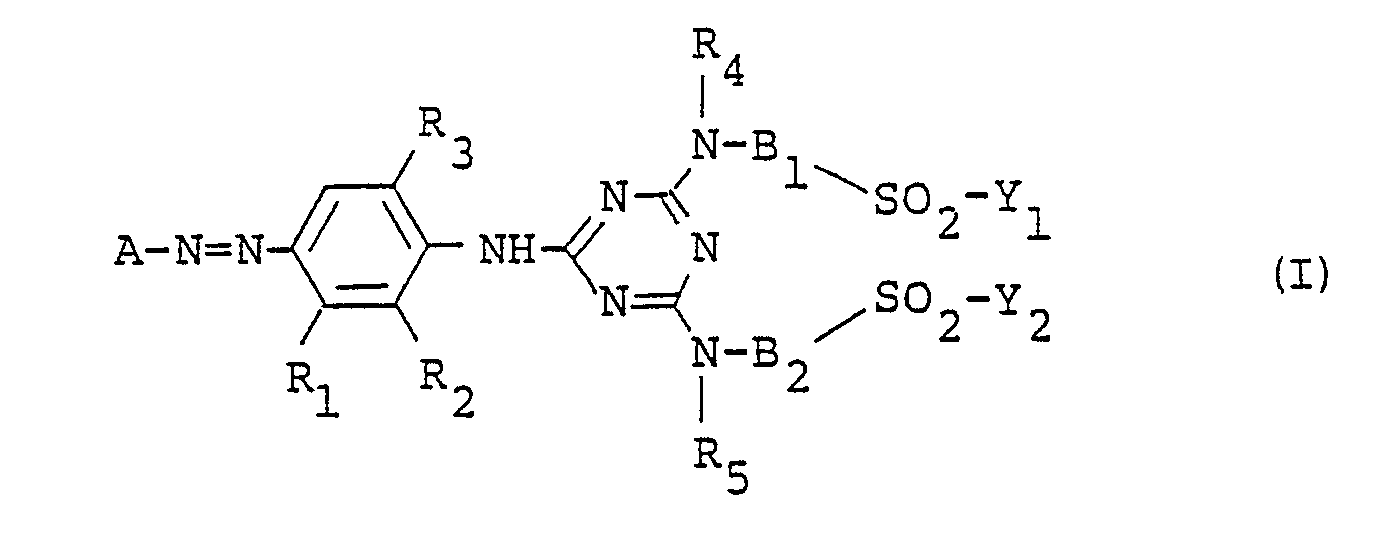
wherein A is a phenyl or naphthyl group substituted with at least one water-solubilizing group, B₁ and B₂ independently of one another are each an unsubstituted or substituted phenylene or naphthylene group, R₁ is hydrogen, halogeno, C 1-4 alkyl, C 1-4 alkoxy, ureido or acylamino, R₂ is hydrogen or taken together with R₁ forms a benzene ring unsubstituted or substituted with at least one sulfo, R₃ is hydrogen, C 1-4 alkyl, C 1-4alkoxy or sulfo, R₄ and R₅ independently of one another are each hydrogen or unsubstituted or substituted alkyl, and Y₁ and Y₂ independently of one another are each vinyl or -CH₂CH₂L in which L is a group splittable by the action of an alkali.
wherein A is a phenyl or naphthyl group substituted with at least one water-solubilizing group, B₁ and B₂ independently of one another are each an unsubstituted or substituted phenylene or naphthylene group, R₁ is hydrogen, halogeno, C 1-4 alkyl, C 1-4 alkoxy, ureido or acylamino, R₂ is hydrogen or taken together with R₁ forms a benzene ring unsubstituted or substituted with at least one sulfo, R₃ is hydrogen, C 1-4 alkyl, C 1-4alkoxy or sulfo, R₄ and R₅ independently of one another are each hydrogen or unsubstituted or substituted alkyl, and Y₁ and Y₂ independently of one another are each vinyl or -CH₂CH₂L in which L is a group splittable by the action of an alkali.
2. A compound according to Claim 1, wherein A is a phenyl group represented by the
following formula,
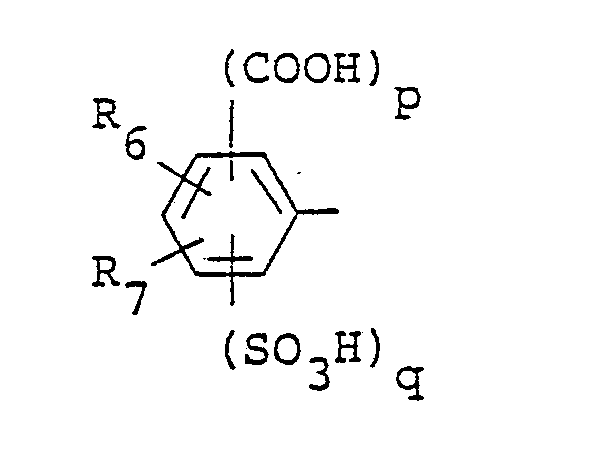
wherein R₆ and R₇ independently of one another are each hydrogen, chloro, methyl or methoxy, p is 0 or 1 and q is 1 or 2, provided that p+q is 1 or 2.
wherein R₆ and R₇ independently of one another are each hydrogen, chloro, methyl or methoxy, p is 0 or 1 and q is 1 or 2, provided that p+q is 1 or 2.
3. A compound according to Claim 1, wherein A is a naphthyl group represented by the
following formula,
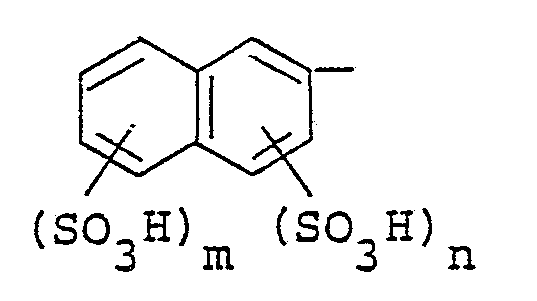
wherein m is 1 or 2 and n is 0 or 1, provided that m+n is 2 or 3.
wherein m is 1 or 2 and n is 0 or 1, provided that m+n is 2 or 3.
4. A compound according to Claim 1, wherein B₁ and B₂ independently of one another
are each a phenylene group unsubstituted or substituted with methyl, methoxy, ethyl,
ethoxy, chloro, bromo, sulfo or carboxy, or a naphthylene group unsubstituted or substituted
with one sulfo.
5. A compound according to Claim 1, wherein B₁ and B₂ independently of one another
are each unsubstituted phenylene or methyl- or methoxy- substituted phenylene.
6. A compound according to Claim 1, wherein R₁ is hydrogen, chloro, methyl, methoxy,
ureido or amino substituted with acetyl, propionyl, -COC₂H₄COOH, -COCH=CHCOOH or benzoyl,
R₂ is hydrogen or taken together with R₁ forms a benzene ring substituted with one
sulfo, and R₃ is hydrogen, methyl or methoxy.
7. A compound according to Claim 1, wherein R₄ and R₅ independently of one another
are each hydrog en, methyl or ethyl.
8. A compound according to Claim 1, wherein both Y₁ and Y₂ are β-sulfatoethyl and
vinyl.
9. A compound of the following formula in the free acid form,
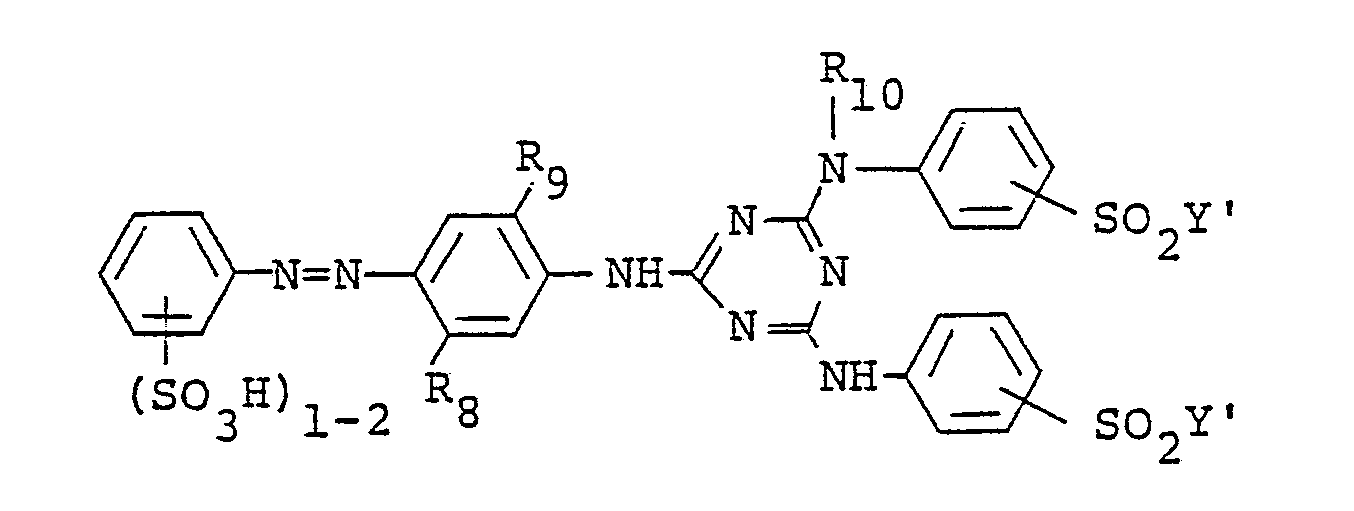
wherein R₈ is ureido or acetylamino and R₉ is hydrogen, or R₈ is methyl and R₉ is methoxy, and R₁₀ is hydrogen, methyl or ethyl, and Yʹ is vinyl or β-sulfatoethyl.
wherein R₈ is ureido or acetylamino and R₉ is hydrogen, or R₈ is methyl and R₉ is methoxy, and R₁₀ is hydrogen, methyl or ethyl, and Yʹ is vinyl or β-sulfatoethyl.
10. A compound of the following formula in the free acid form,
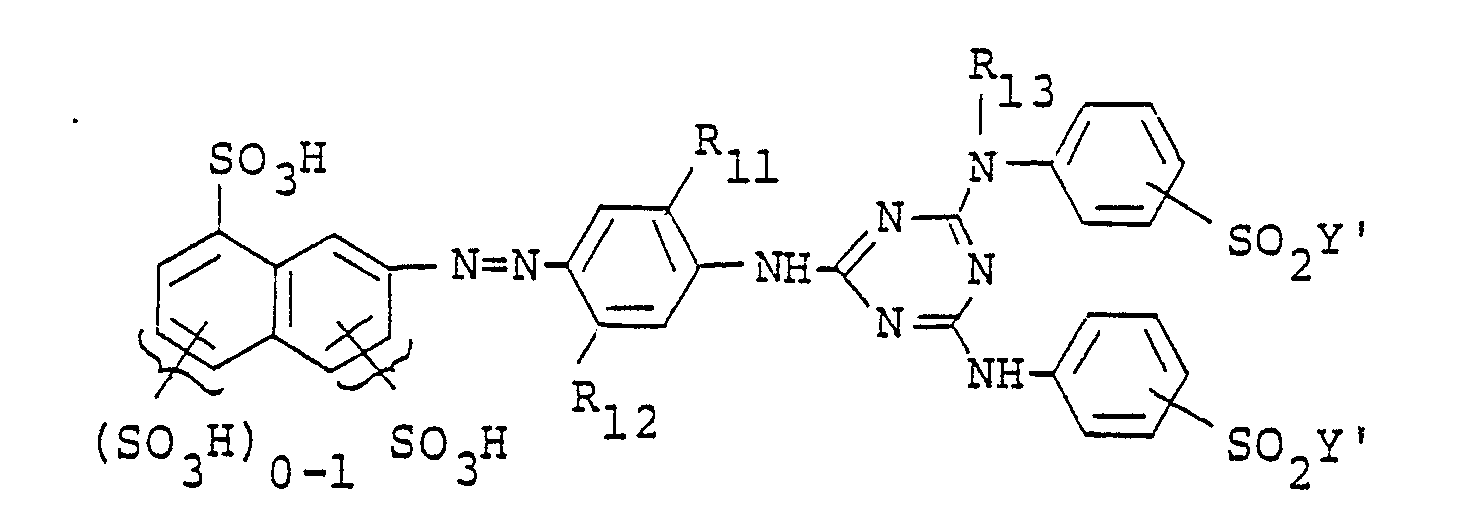
wherein R₁₁ is hydrogen and R₁₂ ureido or acetylamino, or R₁₁ is methoxy and R₁₂ is methyl, and R₁₃ is hydrogen, methyl or ethyl, and Yʹ is vinyl or β-sulfatoethyl.
wherein R₁₁ is hydrogen and R₁₂ ureido or acetylamino, or R₁₁ is methoxy and R₁₂ is methyl, and R₁₃ is hydrogen, methyl or ethyl, and Yʹ is vinyl or β-sulfatoethyl.
11. A process for producing a compound of the formula (I) according to claim 1 which
comprises subjecting any one of a monoazo intermediate compound of the following formula
(II),

wherein A, R₁, R₂ and R₃ are as defined above, an amine compound of the following formula (III),

wherein B₁, R₄ and Y₁ are as defined above, and another amine compound of the following formula (IV),

wherein B₂, R₅ and Y₂ are as defined above, to first condensation with a cyanuric halide, followed by second and third condensations using the remaining ones.
wherein A, R₁, R₂ and R₃ are as defined above, an amine compound of the following formula (III),
wherein B₁, R₄ and Y₁ are as defined above, and another amine compound of the following formula (IV),
wherein B₂, R₅ and Y₂ are as defined above, to first condensation with a cyanuric halide, followed by second and third condensations using the remaining ones.
12. A process for dyeing or printing fiber materials, which comprises using a monoazo
compound of the formula (I) according to claim 1.
13. Fiber materials dyed by the process of Claim 12.
